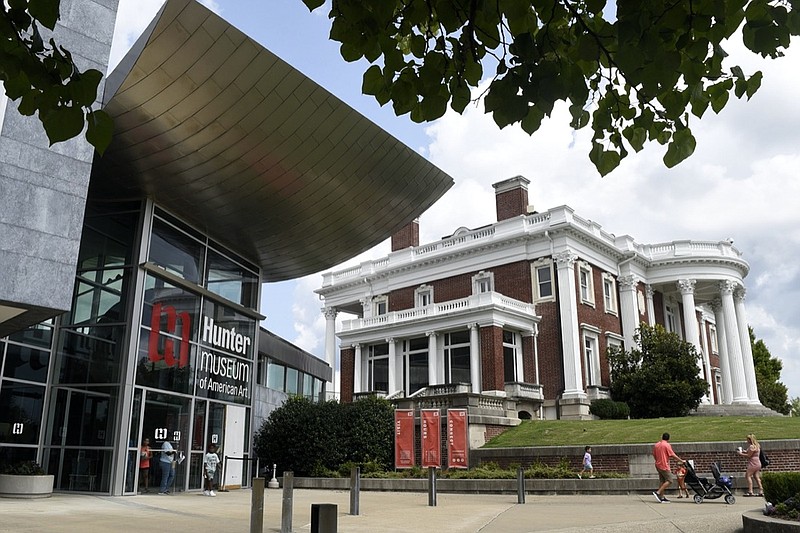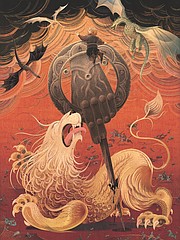If you think art museums are highbrow and stuffy, perhaps a night of cosplay, a visit by a Bigfoot investigator or a drag show will convince you otherwise. Such programs are on the roster for the summer run of "Enchanted: A History of Fantasy Illustration," the second of three 70th anniversary exhibitions this year at the Hunter Museum of American Art.
Situated prominently above the Tennessee River in downtown Chattanooga, this beacon on the bluff is revered as one of America's best midsize art museums. More than 3,000 works reside within the walls of its three buildings: the original mansion, built as a private residence in 1905; the East Wing, added in 1975; and the West Wing, one of several downtown projects completed in 2005 as part of the 21st Century Waterfront development.
Each piece in the Hunter's collection is meant to tell the stories of American art from the 1700s through the present day. Temporary exhibitions such as "Enchanted" also serve to show that the Hunter is "not your grandmother's museum," says Cara McGowan, director of marketing and communications.
It's not solely visual art that draws visitors to the Hunter, which opened in 1952. Staff members also animate the space with guests providing musical performances, poetry nights, yoga sessions and art projects for children.
Recently chief curator Nandini Makrandi and education curator Adera Causey answered questions from Chatter Magazine about the Hunter's past, present and future. This is an edited version of the conversation.
Chatter Magazine: What have been the biggest changes at the Hunter since its founding 70 years ago?
Nandini Makrandi: As far as the biggest changes in 70 years, there are many: the fact that the Hunter started without a collection and now has over 3,000 works; a staff of one person and one building to 50 employees and three large buildings; a rich roster of educational programs and outreach that include a number of strong community partnerships.
The growth and evolution of the Hunter and its offerings have mirrored that of the city, and we continue to work to engage audiences and present artwork that feels relevant, that deepens our understanding of ourselves and others, and that offers new and compelling perspectives.
Chatter: What considerations go into the purchase/exhibition of works now vs. then?
Makrandi: Although the Hunter has always been focused on showing original artwork that represents significant movements in American art, we have made a concerted effort over the last 20 years or so to make sure our acquisitions and exhibitions better reflect the many stories of American art - that means being receptive to what our community wants to see, to reflect our communities' interests and concerns, and to engage through artistic avenues with the issues facing all of us today. We have significantly increased works by female artists and by artists of color and have started to more actively pursue technology-based pieces that reflect our 21st-century world.
Chatter: How far in advance do you know what exhibitions are coming?
Makrandi: Exhibitions are often scheduled two to five years in advance.
Our goal with exhibitions is to show a range of artwork exploring a variety of subjects and concerns relevant to American society, so that in any three- to five-year cycle, you will experience everything from traditional, historic oil paintings to contemporary photography and new media.
Chatter: What have been the standout exhibitions over the years, as far as attendance?
Makrandi: A number of exhibitions have been popular with visitors for a variety of reasons. In the last five years, these have risen to the top: "Embodied Beauty: Sculptures by Karen LaMonte," "Noel W. Anderson: Blak Origin Moment," "Power, Passion & Pose: Photographs by Ken Browar and Deborah Ory," "The Hunter Invitational" and "William J. Glackens and Pierre-Auguste Renoir: Affinities and Distinctions."
Chatter: Is there a "typical" visitor?
Adera Causey: Our typical visitor has changed significantly over the last 20 years. In earlier years our walk-in guests and many of our program attendees were older, white and affluent, and those attending our school programs largely came from private schools or local public schools with students in higher-income areas. Over the years that has changed significantly with general attendance, especially on evenings and weekends, becoming more reflective of our community as a whole.
The museum's public programs, which are intentionally designed to welcome younger audiences and underrepresented voices, often feature BIPOC (Black, indigenous, people of color) presenters and have much younger and much more diverse attendance; likewise, our youth programs, especially our significant outreach efforts, have much stronger and ongoing connections with students in Title I school communities.
Chatter: How did the 2005 expansion and renovation reinvigorate the Hunter?
Causey: The new addition has offered space - in the lobby and on the 24-hour terrace - for larger, more physically active programs and opportunities to draw guests in with a sense of wonder. The reinstallations of the galleries have created more impactful and relevant displays and information that is more guest centered. And, of course, having a larger space for community and private events has allowed many more the chance to experience the beauty of the museum during some very special occasions.
Chatter: What's in the Hunter's future?
Causey: Continuing to create an inclusive, welcoming space with artwork that better reflects the lived experience of a cross-section of America. The future also involves increasingly reaching out to communities and groups who haven't been as involved with the museum and developing programs hand in hand with them and, ideally, led by them.
Chatter: What's something you wish more people knew about the museum?
Causey: That we are here for everyone, and that we welcome ideas. Some of our best offerings have come from community members' suggestions.
'ENCHANTED' PROGRAMMING
The summer exhibition, "Enchanted: A History of Fantasy Illustration," highlighting memorable characters and scenes from fairy tales, myths and legends, is on view through Sept. 5. Here are some of the programs taking place during its run. Find more information at huntermuseum.org.
- June 2: 6-7:30 p.m., Studio Sessions: Chatt and Comix, a beginner-friendly workshop for drawing comics
- June 9: 6-7:30 p.m., Cosplay at the Hunter, a first-time event seeking character costumes from favorite fandoms
- June 30: 6-7 p.m., Fantasy Collecting Panel with stories and tips for new and experienced comics collectors
- July 7: 5:30-7:30 p.m., Fantasy Game Night for table-top gamers
- July 14: 6-7 p.m., Hip Hop Fantasy with inspirations from Dragon Ball Z, Thriller and Rerun rhythms.
- July 21: 7-8:30 p.m., Fantasy Cabaret, a drag show with local performers
- July 28: 6-7 p.m., Bigfoot investigator David Eller talks about sightings in the area
- Aug. 14: 2-4 p.m., Family Fun Day Fairy Tales Enchantment, with art-making stations, scavenger hunts and performances
- Aug. 25: 6-7 p.m., Enchantment with Ballet Esprit, a fantasy-inspired dance performance

